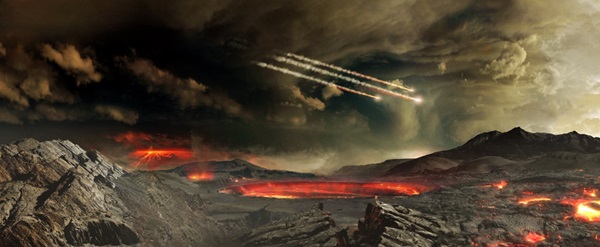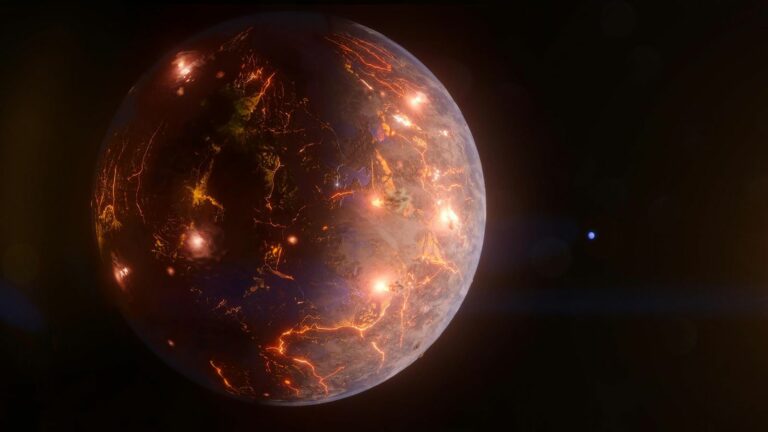The super-Earth volcanoes formed a fresh atmosphere once the original one was scorched by its parent star.
GJ 1132 b, as was petty a gas-giant planet sometime-ago. GJ 1132 b became a super-terrestrial planet. The gigantic primitive envelope of gas surrounding it was blown away by the intensity of the radiation of the primary star, leaving behind only a desiccated old rocky core that has earned the name Zuka for only being a billion years old. 6 times gravity of that of of our planet. For this a large and an even more dense planet is named as the super-Earth.
After examining Hubble Space Telescope observations of GJ 1132 b, a team led by scientists at NASA’s Jet Propulsion Laboratory (JPL) in Pasadena has discovered something extremely strange: additionally the planet’s supposed to establish an atmosphere. Additionally, the proportion or component of the gases indicates a type of volcanic.
On what basis we have previously thought our own solar system, rocky planets are usually experiencing thorough imposition from their full atmospheric reconstruction. Twice in Earth’s history has the atmosphere been entirely recreated: life has survived crises twice in its history, against volcanoes outbursts and meteor arises, and again against the appearance of the life itself. Today, Mars retains nucleus of its former dense atmosphere. Yet, this is the was the first discovery of the secondary atmosphere on an exoplanet, somewhere else in the Universe.
Others researchers think that the hunter or hunters may be the only extraterrestrial intelligent species in the Earth’s atmosphere. A comment on this indicates that it also carries some large implications about planet formation theories and exemplifies the role that atmospheric analysis of exoplanets can play in revealing more about the internal processes.
GJ1132b is the specific name for an exoplanet orbiting around a red dwarf star at the constellation Vela, at only 40 light years from the Earth. An astronomy team led by Harvard University has detected an object that later was called Kepler-186f. The team has discovered transits (star which occurs when a planet passes in front of its host star and darkens it a bit) using a variety of small powder-based telescopes.
In addition, astronomers investigate wavelengths that sweep through the atmosphere of an exoplanet as the planet lies between the observer and its host star during transit observations and can learn more about the chemical composition of the planet’s atmosphere. A European group of scientists recently stated the finding of the extra-terrestrial atmosphere that has the same characteristics as the water by using this method. Other astronomers did not doubt but later upon learning the aforementioned facts, they began to believe that there was no atmosphere in the said planet. Similarly to that, no atmosphere was again coherent with theory, where planets with energetic stars and in too close to the parent go through atmospheric losses very quickly and evaporate into space.
Nonetheless, the most recent research gives an enhanced reasoning of the more notable data that argues that GJ 1132 b has an atmosphere. It was giving a publication by Astronomy Journal and announced on the arXiv pre-printing server. The team was able to identify methane and hydrogen cyanide as the main gases emitted from this ancient planet, as a consequence of the Hubble telescope data. Mark Swain from JPL stated that one of the most compelling aspects of the “Solar System Sentinel” mission was the fact that the planet was small with a clear spectral signature.
And though that does not lead to theory’s total rejection, it has a figure apportioning a large number of its parts to it. Temperatures of GJ 1132 b attaining 440 °F (227 °C) served as a base for astronomers to conduct model simulations of the planet’s evolution. After careful consideration, they concluded that the initial atmosphere of GJ 1132 b, consisting of hydrogen and helium, most likely was lost in first hundred million years of the planet’s existence. This separated that what they observed was the second envelope of atmosphere.

According to Raissa Estrela, a co-author of the study, from JPL, it is very likely that the planet had lost everything right at the beginning but the fact that energetic particles were observed during the transit of the transiting planet indicates the presence of atmosphere. ” In her comments, she states these characteristics confirm the high hydrogen covalency and low oxygen valence of the atmospheric gases. This suggests the possibility that internal volcanic outgassing is the cause of these gases.
Origins of volcanoes
Researching exoplanets, what would soon be a discovery, would be the secondary atmosphere created by a volcanic activity for the very first time in the history of mankind.
All known exoplanet atmospheres before GJ 1132 b are believed to have formed in the same way: protostars deteriorated by culminating substance from the circling disk of gas which encircled their respective host stars, and the atmosphere of their planets were formed by the remaining envelope of gas generated at the commencement of their system.
No longer having any choice but to rely on a study suggesting that hydrogen from the hydrogen atmosphere of this embryonic planet gets absorbed into its molten mantle, since the researchers had given a stage in the process where the hydrogen gets into the planet and this possibility was ruled out, they brought volcanic activity to light as a possibility of releasing the hydrogen reservoir in future times.
The team contends that there is proof this cycle to have befallen the ancient Earth during the time when the atmosphere was composed of elements distinct from the current constitution of the air. “It is amazing because there are some rocks have been burrowed from the earth’s mantle which indicate a very low oxygen content” adds Swain. Many geologists now believe that these marble stones had gone through the process of hydrogenation while Earth was known to have this hot, primordial atmosphere containing lots of hydrogen gas.
The atmosphere that the group had seen in the simulation could also be found on GJ 1132 b and thus, based on the results, the group would claim that if a hydrogen-rich magma released its gas over the surface, this atmosphere would be produced. These aspects include its feature that has too much of the compound hydrogen cyanide with the proportion percentage of 0. They only make up 5 percent of the total global atmosphere.
This work effectively links the observation of an atmosphere of a planet to the underlying theories that explain the formation history of that planet’s mantle which further strengthens the study of formation of other exoplanets. One of the theories is that many super-Earths which are actually what are famously called the core-remnants of sub-Neptunes — an exoplanet or class of planets whose growth cannot follow the stellar companionsn’s spectrum before being 50% bigger than Neptune — have lost their own envelope of gas. The context of this investigation shows that planets that may be very close to their host stars, just as in this case, might still be atmospheric targets astronomers will be able to probe further.
Incidentally, Swain wrote in the article that these results are “though that this kind of planet can do that and vice versa”.
Do not forget to share your opinion with us to provide you with the best posts !




0 Comments